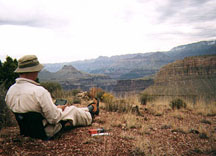[ Lay Language Paper Index | Press Room ]
Nicholas P. Miller, http://www.hmmh.com
Harris Miller Miller & Hanson Inc.
15 New England Executive Park
Burlington, MA 01803
(781) 229-0707
Popular version of paper 3aNS6
Presented Wednesday morning, 10:20 am, November 3, 1999
138th ASA Meeting, Columbus, Ohio

|
National Parks are established by Congress to
preserve our national heritage, whether it is the natural beauty of the Grand
Canyon, the historic importance of Gettysburg, or the cultural significance of
Mesa Verde. Each park is set aside to protect various types of resources that
the public has come to value. Over the past decade, park management, park
visitors and the public at large have become aware of the growing intrusion into
some of our parks of the sounds of civilization. Autos, buses, power boats,
snowmobiles, aircraft and other powered transportation and recreational craft
create sounds that may be heard miles away in the otherwise undisturbed natural
soundscapes of some parks.
Since 1987, the National Park Service and the Federal Aviation Administration have worked to find ways for effectively and fairly managing the noise produced by air tours over some of our parks. These two agencies have directed research efforts with the goal of not only understanding the nature and extent of noise intrusions, but also of providing objective tools for management of park and air space use. This paper presents the results of some of that research, showing how measurements of the sound of air tours can be used to estimate the amount of disturbance that will result for park visitors. Noise measurements and simultaneous surveys of visitors were made at six different sites in three national parks. The second-by-second records of sound levels, together with the visitor survey results and continuous logs of the sound sources heard, permitted development of "dose-response" relationships. These relationships reveal what percent of visitors were disturbed (their response) for different levels of aircraft sound exposure (the dose). Park and airspace management decision-makers can now have an objective understanding of the significance that air tour noise has for visitors in situations that are similar to those from which the dose-response relationships were developed. By either measuring or calculating the loudness and the duration of aircraft noise, an estimate may be made of what percent of visitors will find the noise annoying or believe that it interferes with their enjoyment of the natural sounds. If, for example, aircraft sound levels are no more than about 10 to 15 decibels higher than the natural levels, and are audible less than about 30% of the time, fewer than one-quarter of the visitors are likely to feel annoyed by the noise. However, the type of location in a park where the aircraft are heard plays a role in how visitors react. The conditions given above apply to a site that is accessed by a short hike – by walking about 15 minutes or more. For an overlook type location, where only a short walk from the car is necessary, the aircraft sound levels and durations given above might annoy about 5 to 10 percent of the visitors. By combining the dose-response information with the type of park location, management decisions may be made about what flight corridor locations and numbers of air tour operations are compatible with park management goals for visitor experience. |
[ Lay Language Paper Index | Press Room ]